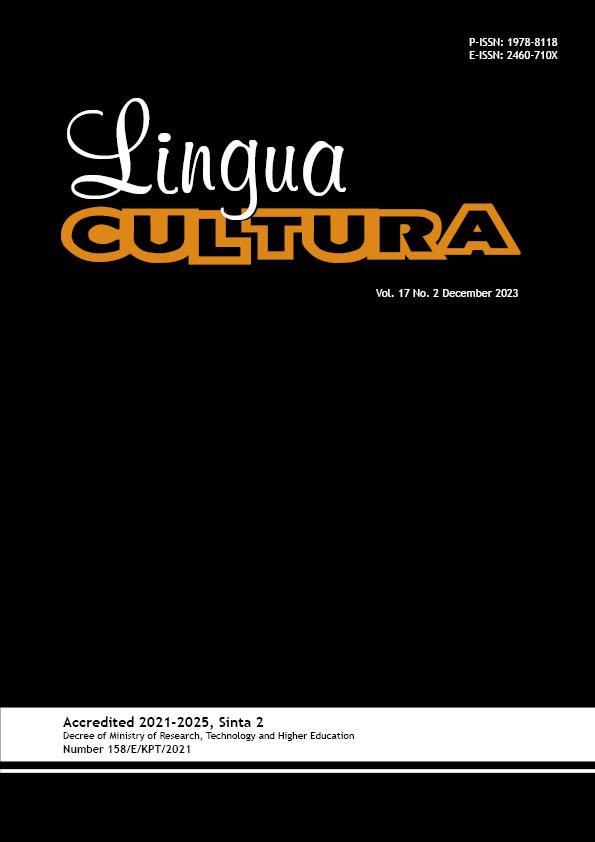Code Switching and Code Mixing Practised By K-POP Idols Diaspora
DOI:
https://doi.org/10.21512/lc.v17i2.10399Keywords:
code-switching, code-mixing, K-pop idols, Korean diasporaAbstract
The research discussed K-pop idols as ambassadors for brands, contributing to the global popularity of K-pop as a cultural phenomenon. Given their strong influence and popularity, it was fascinating to discern how K-Pop idols' diaspora communicates with each other. By using the descriptive-qualitative approach with the interpretive-explorative pattern, the research was intended to examine the practice of code-switching and code-mixing by K-pop idols' diaspora during their interaction, to enumerate the code-switching and code-mixing instances, as well as to study the reasons/motivations behind the use of using code-switching and code-mixing. The result of the data analysis confirmed that, like other bilinguals, K-Pop idol's diaspora utilize code switching and code mixing during their interaction for various underlying reasons. It is found that there are 19 inter-sentential switchings, 18 intra-sentential switching, four tag switching, 11 insertion code-mixing, four alternation code-mixing, and six congruent lexicalizations with different reasons or motivations. The research concluded that it is almost inevitable for bilinguals and multilinguals to practice code- switching and code-mixing to navigate language selection during their interaction.
References
Al Rousan, R., & Merghmi, K. (2019). A conversational analysis of Arabic-French code-switching in Algerian TV talk shows. Jordan Journal of Modern Languages and Literatures, 11(3), 247-271.
Andre, R. (2018). Bahasa Indonesia-English code-mixing in writing business emails: Understanding the communicative purpose. Lingua Cultura, 12(2), 117-121. https://doi.org/10.21512/lc.v12i2.3733.
Anggraeni, M. (2016). The reasons of using code switching for English education students in facebook at Universitas Kristen Satya Wacana Salatiga, Indonesia. (Thesis). Salatiga, Indonesia: Universitas Kristen Satyawacana. Retrieved from https://repository.uksw.edu/handle/123456789/9420.
Ariasih, N. P. L., Jendra, I. M. I. I., & Sulatra, I. K. (2021). Types of code-switching found in the Twitters of the Indonesian kpop fans. Journal of Language and Applied Linguistics, 2(2), 96-108. https://doi.org/10.22334/traverse.v2i2.36.
Astutik, R. P. (2018). Code-switching and code-mixing used by expert in the concerts of Rising Star Indonesia on RCTI. (Thesis). Ponorogo, Indonesia: IAIN Ponorogo. Retrieved from http://etheses.iainponorogo.ac.id/2527/1/Ratna Puji Astutik.pdf.
Fadil, R., & Andriani, D. I. (2021). Code-mixing used in Masterchef Indonesia season 5. VELES Voices of English Language Education Society, 5(2), 167-182. https://doi.org/10.29408/veles.v5i2.3862.
Hutriani, M. F. (2019). Indonesian-English code-mixing used by the presenters of breakout music program. Retrieved from http://scholar.unand.ac.id/45283/.
Jayanti, I. G. N., Wirawan, I. K. A., Susanthi, N. L., & Sujayanthi, N. W. M. (2022). Korean pop (K-pop) culture phenomenon on the behavior of Indonesian society. Journal of Art, Film, Television, Animation, Games and Technology, 1(1), 44-50.
Karjo, C. H., & Alyarizky, F. (2021). Social relation that triggers the use of code-switching in the novel the Architecture of Love by Ika Natassa. Lingua Cultura, 15(2), 215-221. https://doi.org/10.21512/lc.v15i2.7328.
Maghfiroh, L. (2018). An analysis on form, function, and reason of code-switching and code-mixing used in Vlog of Shirin Al Athrus. (Thesis). Salataiga, Indonesia: IAIN Salatiga. Retrieved from http://e-repository.perpus.iainsalatiga.ac.id/4163/.
Muysken, P. (2000). Bilingual speech: A typology of code-mixing. Cambridge, UK: Cambridge University. Retrieved from https://repository.ubn.ru.nl/bitstream/handle/2066/43052/268171.pdf.
Nassaji, H. (2020). Good qualitative research. Language Teaching Research, 24(4), 427-431. https://doi.org/10.1177/1362168820941288.
Nguyen, L., Yuan, Z., & Seed, G. (2022). Building educational technologies for code-switching: Current practices, difficulties and future directions. Languages, 7(3), 1-18. https://doi.org/10.3390/languages7030220.
Novedo, N., & Linuwih, E. R. (2018). Code switching and code mixing used by Sarah Sechan and Cinta Laura in Sarah Sechan talk show. Seminar Nasional Ilmu Terapan (SNITER) 2018, 2(1), 1-8.
Poplack, S. (1980). Sometimes I’ll start a sentence in Spanish y termino en Espanol: Toward a typology of code-switch. Linguistics, 18(7/8), 581-618.
Saraswati, N. K. D., Suarnajaya, I. W., & Putra, I. N. A. J. (2022). Code mixings used by beauty vloggers. Lingua Scientia, 29(2), 71-76.
Silaban, S., & Marpaung, T. I. (2020). An analysis of code-mixing and code-switching used by Indonesia Lawyers Club on TV One. Journal of English Teaching as a Foreign Language, 6(3), 1-17.
Suardhana, I. P. (2022). The code-switching used in Deddy Corbuzier’s Youtube podcast. Pustaka: Jurnal Ilmu-Ilmu Budaya, 22(1), 49-54. https://doi.org/10.24843/pjiib.2022.v22.i01.p08.
Wibowo, A. I., Idah, Y., & Fera, N. (2017). Analysis of types code switching and code mixing by the sixth President of Republic Indonesia. Progressive Journal, 12(2), 13-22.
Yuliana, N., Luziana, A. R., & Sarwendah, P. (2015). Code-mixing and code-switching of Indonesian celebrities: A comparative study. Lingua Cultura, 9(1), 47-54. https://doi.org/10.21512/lc.v9i1.761.
Downloads
Published
How to Cite
Issue
Section
License
Copyright (c) 2023 muhartoyo muhartoyo

This work is licensed under a Creative Commons Attribution-ShareAlike 4.0 International License.
Authors who publish with this journal agree to the following terms:
a. Authors retain copyright and grant the journal right of first publication with the work simultaneously licensed under a Creative Commons Attribution License - Share Alike that allows others to share the work with an acknowledgment of the work's authorship and initial publication in this journal.
b. Authors are able to enter into separate, additional contractual arrangements for the non-exclusive distribution of the journal's published version of the work (e.g., post it to an institutional repository or publish it in a book), with an acknowledgment of its initial publication in this journal.
c. Authors are permitted and encouraged to post their work online (e.g., in institutional repositories or on their website) prior to and during the submission process, as it can lead to productive exchanges, as well as earlier and greater citation of published work.
USER RIGHTS
All articles published Open Access will be immediately and permanently free for everyone to read and download. We are continuously working with our author communities to select the best choice of license options, currently being defined for this journal as follows: Creative Commons Attribution-Share Alike (CC BY-SA)


















